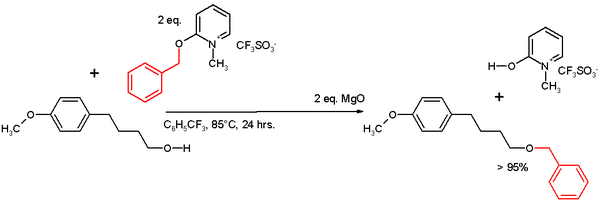Benzyl

In organic chemistry, benzyl is the substituent or molecular fragment possessing the structure C6H5CH2-. Benzyl features a benzene ring attached to a CH2 group.[1]
Nomenclature
In IUPAC nomenclature the prefix benzyl refers to a C6H5CH2 substituent, for example benzyl chloride or benzyl benzoate. Benzyl is not to be confused with phenyl with the formula C6H5. The term benzylic is used to describe the position of the first carbon bonded to a benzene or other aromatic ring. For example the molecule, is referred to as a "benzylic" carbocation. The benzyl free radical has the formula C6H5CH2. The benzyl carbocation has the formula C6H5CH2+; the carbanion has the formula C6H5CH2−. None of these species can be formed in significant amounts under normal conditions, but they are useful referents for discussion of reaction mechanisms.
Abbreviations
The abbreviation "Bn" is frequently used to denote benzyl groups in nomenclature and structural depictions of chemical compounds. For example, benzyl alcohol can be represented as BnOH. This abbreviation is not to be confused with "Bz", which is the abbreviation for the benzoyl group C6H5C(O)−, or the phenyl group C6H5, abbreviated "Ph".
Reactivity of benzylic centers
The enhanced reactivity of benzylic positions is attributed to the low bond dissociation energy for benzylic C−H bonds. Specifically, the bond C6H5CH2−H is about 10–15% weaker than other kinds of C−H bonds. The neighboring aromatic ring stabilizes benzyl radicals. The data tabulated below compare benzylic C−H bond to related C−H bond strengths.
| Bond | Bond | Bond-dissociation energy | Comment | |
|---|---|---|---|---|
| (kcal/mol) | (kJ/mol) | |||
| C6H5CH2−H | benzylic C−H bond | 90 | 377 | akin to allylic C−H bonds such bonds show enhanced reactivity |
| H3C−H | Methyl C−H bond | 105 | 439 | One of the strongest aliphatic C−H bonds |
| C2H5−H | Ethyl C−H bond | 101 | 423 | slightly weaker than H3C−H |
| C6H5−H | phenyl C−H bond | 113 | 473 | comparable to vinyl radical, rare |
| CH2=CHCH2−H | allylic C–H bond | 89 | 372 | such bonds show enhanced reactivity |
The weakness of the C−H bond reflects the stability of the benzylic radical. For related reasons, benzylic substituents exhibit enhanced reactivity, as in oxidation, free radical halogenation, or hydrogenolysis. As a practical example, in the presence of suitable catalysts, p-xylene oxidizes exclusively at the benzylic positions to give terephthalic acid:
- CH3C6H4CH3 + 3 O2 → HO2CC6H4CO2H + 2 H2O.
Millions of tonnes of terephthalic acid are produced annually by this method.[2]
Benzyl protective groups
Benzyl groups are frequently used in organic synthesis as protective group for alcohols and carboxylic acids.
Two common methods for benzyl ether protection:
- reaction of alcohol with benzyl bromide and a strong base such as sodium hydride as in a Williamson ether synthesis[3]
- reaction of alcohol with an imidate such as benzyl trichloroacetimidate (C6H5CH2OC(CCl3)=NH) promoted by trifluoromethanesulfonic acid. An example forming a p-methoxybenzyl (PMB) ether in total synthesis:[4]
The benzyl group can be removed by hydrogenolysis. PMB ethers can be cleaved by magnesium bromide –dimethyl sulfide, CAN or DDQ.[5]
One study [6] employs a benzyloxy pyridinium salt as a benzyl transfer reagent for alcohols:
Trifluorotoluene was used as the solvent in the presence of magnesium oxide as an acid scavenger. The reaction type for this conversion is believed to be SN1 based on the detection of trace amounts of Friedel-Crafts reaction side-products with toluene as a solvent.
References
- ↑ Carey, F. A., and Sundberg, R. J.; Advanced Organic Chemistry, Part A: Structure and Mechanisms, 5th ed.; Springer: New York, NY, 2008. pp 806–808, 312–313.
- ↑ Richard J. Sheehan, "Terephthalic Acid, Dimethyl Terephthalate, and Isophthalic Acid" in Ullmann's Encyclopedia of Industrial Chemistry, Wiley-VCH, Weinheim, 2002. doi:10.1002/14356007.a26_193
- ↑ DeSelms, R. H.; Benzyl Phenyl Ether Compounds; Enigen Science Publishing: Washington, DC, 2008.
- ↑ Total synthesis of rutamycin B via Suzuki macrocyclization James D. White, Thomas Tiller, Yoshihiro Ohba, Warren J. Porter, Randy W. Jackson, Shan Wang, and Roger Hanselmann 80 Chem. Commun., 1998 doi:10.1039/a707251a
- ↑ Protecting groups Krzysztof Jarowicki and Philip Kocienski J. Chem. Soc., Perkin Trans. 1, 1998, 4005–4037 4005 doi:10.1039/a803688h
- ↑ K. W. C. Poon and G. B. Dudley (2006). "Mix-and-Heat Benzylation of Alcohols Using a Bench-Stable Pyridinium Salt". J. Org. Chem. 71 (10): 3923–3927. doi:10.1021/jo0602773. PMID 16674068.
External links
- Chemistry portal
 Quotations related to Benzyl at Wikiquote
Quotations related to Benzyl at Wikiquote

